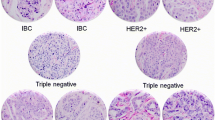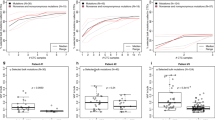Abstract
The human epidermal growth factor receptor 2 (HER2) gene is located on the long arm of chromosome 17 (Chr-17). While primary tumors with Chr-17 polysomy (polysomy 17) are histopathologically similar to HER2-negative tumors, the role of polysomy 17 in circulating tumor cells (CTCs) is still unknown. We report the detection rate of polysomy 17 in CTCs in patients with metastatic breast cancer (MBC). We determined the CTC count per 7.5 ml blood and polysomy 17 in CTCs at 3- to 4-week intervals up to 12 weeks in 52 patients. Polysomy was defined as Chr-17 ≥2.2. CTCs were detected in 40 of 52 patients (76.9%) during the study period, in 32 of the 52 patients (61.5%) at baseline, and in 21 of 49 patients (42.9%) at 3–4 weeks. Polysomy 17 in CTCs was present in 10 of 52 patients (19.2%) during the study period, in 5 of 52 patients (9.6%) at baseline, and in 7 of 49 patients (14.3%) at 3–4 weeks. The individual patient counts of polysomy 17 in CTCs/total count of CTCs examined for polysomy 17 at 3–4 weeks were 1/1, 1/7, 1/7, 2/27, 2/30, 2/50, and 3/50. Six of the 7 patients with polysomy 17 in CTCs had HER2-negative primary tumors. None of the CTCs displaying polysomy 17 themselves had HER2 amplification by FISH. In summary, polysomy 17 in CTCs was observed in only a small population of patients with MBC. We should prospectively evaluate its prognostic value in both HER2-positive and -negative metastatic breast cancer.
Similar content being viewed by others
References
Slamon DJ, Godolphin W, Jones LA et al (1989) Studies of the HER-2/neu proto-oncogene in human breast and ovarian cancer. Science 244:707–712
Vogel CL, Cobleigh MA, Tripathy D et al (2002) Efficacy and safety of trastuzumab as a single agent in first-line treatment of HER2-overexpressing metastatic breast cancer. J Clin Oncol 20:719–726
Clark GM, McGuire WL (1991) Follow-up study of HER-2/neu amplification in primary breast cancer. Cancer Res 51:944–948
Revillion F, Bonneterre J, Peyrat JP (1998) ERBB2 oncogene in human breast cancer and its clinical significance. Eur J Cancer 34:791–808
Esteva FJ, Valero V, Booser D et al (2002) Phase II study of weekly docetaxel and trastuzumab for patients with HER-2-overexpressing metastatic breast cancer. J Clin Oncol 20:1800–1808
Seidman AD, Fornier MN, Esteva FJ et al (2001) Weekly trastuzumab and paclitaxel therapy for metastatic breast cancer with analysis of efficacy by HER2 immunophenotype and gene amplification. J Clin Oncol 19:2587–2595
Slamon DJ, Leyland-Jones B, Shak S et al (2001) Use of chemotherapy plus a monoclonal antibody against HER2 for metastatic breast cancer that overexpresses HER2. N Engl J Med 344:783–792
Smith I, Procter M, Gelber RD et al (2007) 2-year follow-up of trastuzumab after adjuvant chemotherapy in HER2-positive breast cancer: a randomised controlled trial. Lancet 369:29–36
Pauletti G, Godolphin W, Press MF et al (1996) Detection and quantitation of HER-2/neu gene amplification in human breast cancer archival material using fluorescence in situ hybridization. Oncogene 13:63–72
Downey L, Livingston RB, Koehler M et al (2010) Chromosome 17 polysomy without human epidermal growth factor receptor 2 amplification does not predict response to lapatinib plus paclitaxel compared with paclitaxel in metastatic breast cancer. Clin Cancer Res 16:1281–1288
Vanden Bempt I, Van Loo P, Drijkoningen M et al (2008) Polysomy 17 in breast cancer: clinicopathologic significance and impact on HER-2 testing. J Clin Oncol 26:4869–4874
Dowsett M, Procter M, McCaskill-Stevens W et al (2009) Disease-free survival according to degree of HER2 amplification for patients treated with adjuvant chemotherapy with or without 1 year of trastuzumab: the HERA Trial. J Clin Oncol 27:2962–2969
Hofmann M, Stoss O, Gaiser T et al (2008) Central HER2 IHC and FISH analysis in a trastuzumab (Herceptin) phase II monotherapy study: assessment of test sensitivity and impact of chromosome 17 polysomy. J Clin Pathol 61:89–94
Watters AD, Going JJ, Cooke TG et al (2003) Chromosome 17 aneusomy is associated with poor prognostic factors in invasive breast carcinoma. Breast Cancer Res Treat 77:109–114
Hyun CL, Lee HE, Kim KS et al (2008) The effect of chromosome 17 polysomy on HER-2/neu status in breast cancer. J Clin Pathol 61:317–321
Downs-Kelly E, Yoder BJ, Stoler M et al (2005) The influence of polysomy 17 on HER2 gene and protein expression in adenocarcinoma of the breast: a fluorescent in situ hybridization, immunohistochemical, and isotopic mRNA in situ hybridization study. Am J Surg Pathol 29:1221–1227
Reinholz MM, Bruzek AK, Visscher DW et al (2009) Breast cancer and aneusomy 17: implications for carcinogenesis and therapeutic response. Lancet Oncol 10:267–277
Merola R, Mottolese M, Orlandi G et al (2006) Analysis of aneusomy level and HER-2 gene copy number and their effect on amplification rate in breast cancer specimens read as 2+ in immunohistochemical analysis. Eur J Cancer 42:1501–1506
Cristofanilli M, Broglio KR, Guarneri V et al (2007) Circulating tumor cells in metastatic breast cancer: biologic staging beyond tumor burden. Clin Breast Cancer 7:471–479
Cristofanilli M, Budd GT, Ellis MJ et al (2004) Circulating tumor cells, disease progression, and survival in metastatic breast cancer. N Engl J Med 351:781–791
Cristofanilli M, Hayes DF, Budd GT et al (2005) Circulating tumor cells: a novel prognostic factor for newly diagnosed metastatic breast cancer. J Clin Oncol 23:1420–1430
Hayes DF, Cristofanilli M, Budd GT et al (2006) Circulating tumor cells at each follow-up time point during therapy of metastatic breast cancer patients predict progression-free and overall survival. Clin Cancer Res 12:4218–4224
Nakamura S, Yagata H, Ohno S et al (2009) Multi-center study evaluating circulating tumor cells as a surrogate for response to treatment and overall survival in metastatic breast cancer. Breast Cancer 17:199–204
Yagata H, Nakamura S, Toi M et al (2008) Evaluation of circulating tumor cells in patients with breast cancer: multi-institutional clinical trial in Japan. Int J Clin Oncol 13:252–256
Fehm T, Becker S, Duerr-Stoerzer S et al (2007) Determination of HER2 status using both serum HER2 levels and circulating tumor cells in patients with recurrent breast cancer whose primary tumor was HER2 negative or of unknown HER2 status. Breast Cancer Res 9:R74
Reuben JM, Lee BN, Li C et al (2007) Genomic of circulating tumor cells in metastatic breast cancer. J Clin Oncol 25:1002
Wolff AC, Hammond ME, Schwartz JN et al (2007) American Society of Clinical Oncology/College of American Pathologists guideline recommendations for human epidermal growth factor receptor 2 testing in breast cancer. J Clin Oncol 25:118–145
Shimada M, Imura J, Kozaki T et al (2005) Detection of Her2/neu, c-MYC and ZNF217 gene amplification during breast cancer progression using fluorescence in situ hybridization. Oncol Rep 13:633
Meng S, Tripathy D, Shete S et al (2004) HER-2 gene amplification can be acquired as breast cancer progresses. Proc Natl Acad Sci USA 101:9393–9398
Therasse P, Arbuck SG, Eisenhauer EA et al (2000) New guidelines to evaluate the response to treatment in solid tumors. European Organization for Research and Treatment of Cancer, National Cancer Institute of the United States, National Cancer Institute of Canada. J Natl Cancer Inst 92:205–216
Acknowledgments
The authors thank Bibari Nakamura, Keiko Shimizu, and all the staff from the Department of Breast Surgical Oncology, St. Luke’s International Hospital, for help in collecting clinical data; Masayuki Shimada, Takeshi Watanabe, and Yuki Matsuo from SRL Inc. for tissue analysis; and Sunita Patterson from the Department of Scientific Publications, MD Anderson Cancer Center, for editorial review. This research is supported in part by the National Institutes of Health through MD Anderson’s Cancer Center Support Grant, CA016672, and the Nellie B. Connally Breast Cancer Research Fund.
Conflict of interest
G. N. Hortobagyi is a consultant to Merck, Novartis, and Sanofi-aventis, and received research funding from Novartis. Y. Shimada has employment with SRL Inc. The other authors have no conflict of interest.
Author information
Authors and Affiliations
Corresponding author
About this article
Cite this article
Hayashi, N., Nakamura, S., Yagata, H. et al. Chromosome 17 polysomy in circulating tumor cells in patients with metastatic breast cancer: a case series. Int J Clin Oncol 16, 596–600 (2011). https://doi.org/10.1007/s10147-010-0173-3
Received:
Accepted:
Published:
Issue Date:
DOI: https://doi.org/10.1007/s10147-010-0173-3




